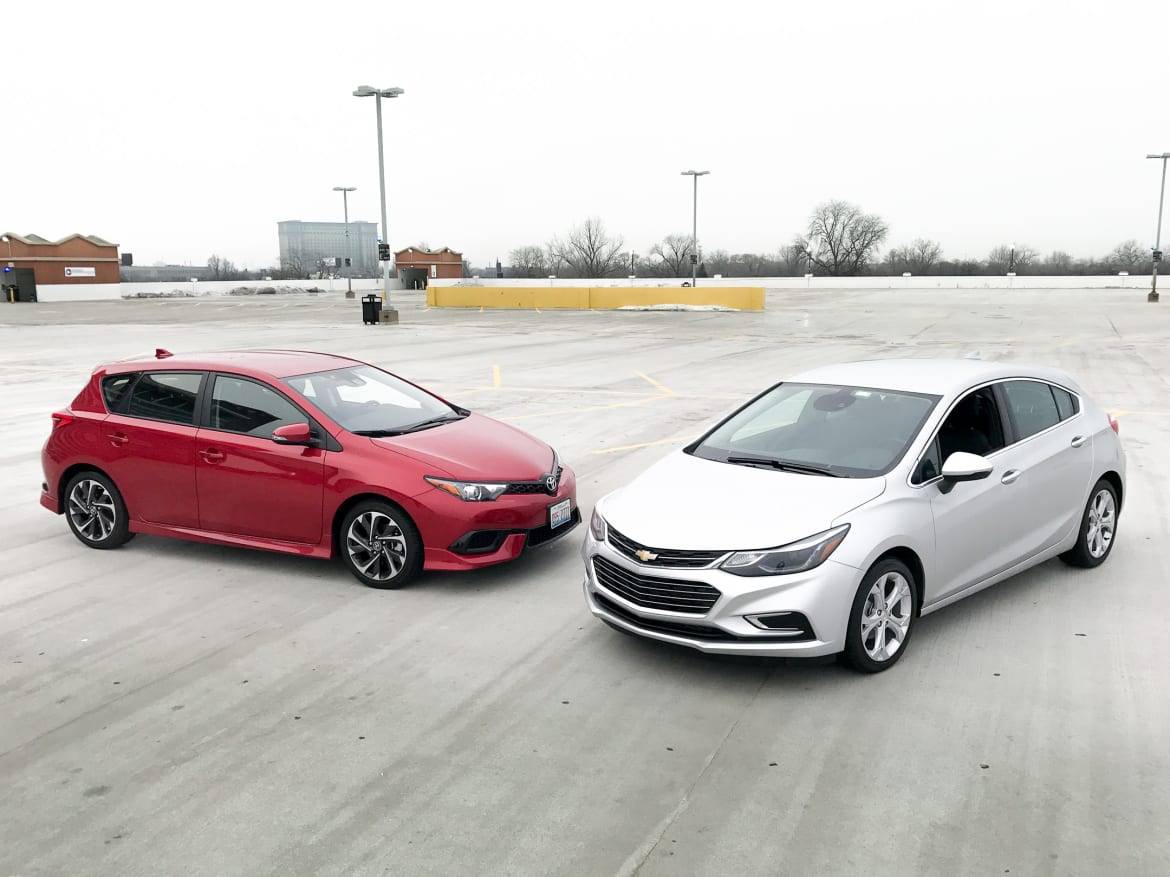Hatchbacks Face Off in Fuel-Economy Test


CARS.COM — In terms of sales, cars took a backseat to SUVs in 2016, but what’s great about hatchbacks is that they’re small, low-riding SUVs without all-wheel drive but with better fuel economy. We put two new compact hatchbacks, the 2017 Chevrolet Cruze and 2017 Toyota Corolla iM (formerly the Scion iM) to the test to gauge fuel economy. Yes, gas prices are still low, but chances are if you’re looking for a compact car, fuel economy is likely still a priority.
Related: 2017 Chevrolet Cruze Hatchback Review: First Drive
Cars.com reviewer Mike Hanley and I buckled into the Cruze Hatchback and Corolla iM for a 600-mile fuel-economy test from Chicago to Detroit and back to see which one used the least fuel. Ratings favor the Cruze ever so slightly with 1 mpg more in combined EPA ratings: The Corolla iM is rated at 28/36/31 mpg city/highway/combined with the automatic transmission and the Cruze is 29/38/32 mpg with the automatic transmission.
After driving each car 600 miles, the Corolla iM performed a bit better than the Cruze with 34.6 mpg compared with the Cruze’s 34.2 mpg. Fuel economy is basically a draw between these two cars, but there are many other factors that differentiate them. One car is considerably more pleasant to drive for 600 miles, but also more expensive.
The 2017 Toyota Corolla iM is unlike the Corolla sedan you probably know. Toyota adopted the former Scion iM after canceling the Scion brand. The Corolla iM is $20,380, including the destination charge and automatic transmission, and has extremely limited optional equipment. There are no options or extra features other than dealer-installed accessories, so what you see is what you get. On the plus side, a base model like our test car includes a forward collision warning system with automatic braking. On the downside, heated seats or satellite radio aren’t available.
The Cruze’s as-tested price of $26,475 is nearly 30 percent more than the Corolla iM — a significant difference. The Cruze, however, is packed with high-tech features. Not only did our Cruze have heated seats at this price, but it had a heated steering wheel, remote start and in-car wireless internet with a subscription-based 4G LTE connection. Like the iM, the Cruze has forward collision warning with automatic braking and a lane departure prevention system, though only available on the top Premier trim level. My passengers and I used the in-car wireless extensively running navigation and streaming music from my phone while a colleague connected to the internet to wrap-up Detroit auto show coverage; it worked seamlessly for all of us.
The Cruze is also the more refined hatchback to drive. Our route was highway heavy with round-trip speeds averaging around 59 mph (Cruze 59.7 mph and iM 58.5 mph). There was less wind and road noise, and it had a quieter engine and a firmer ride quality that wasn’t rough. The Cruze hatchback’s handling is tuned to be entertaining while whipping onto highway entrances. The Corolla iM’s continuously variable automatic transmission does an admirable job of being responsive and providing on-demand power, but it was overactive and seemingly always racing the engine. A noisy engine only made it more noticeable that the transmission rarely settled into a constant operation.
However, the Cruze is a decidedly different vehicle when it costs $20,000 like the iM. For one, the hatchback isn’t available at that price considering its starting price of $22,795 with automatic transmission, and that doesn’t include remote start, a heated steering wheel or forward collision warning; Wi-Fi is standard, however, for a trial before a subscription is required. The Cruze is still the better driving of the two at that lower price, and the as-tested $26,000 Cruze Hatchback at least feels like a difference class of vehicle.
How We Conducted the Test
The final fuel-economy numbers are an average of each car’s onboard trip computer and calculated fill-up measurements dividing the number of miles driven by gallons used. The single average for each car combines fuel economy results from both trips. Each car had two or more occupants, and we switched cars on the return trip to spread driving styles across both cars and keep loads similar — all luggage and passengers followed the driver.

Managing Editor Joe Bruzek’s 22 years of automotive experience doesn’t count the lifelong obsession that started as a kid admiring his dad’s 1964 Chevrolet Corvette — and continues to this day. Joe’s been an automotive journalist with Cars.com for 16 years, writing shopper-focused car reviews, news and research content. As Managing Editor, one of his favorite areas of focus is helping shoppers understand electric cars and how to determine whether going electric is right for them. In his free time, Joe maintains a love-hate relationship with his 1998 Pontiac Firebird Trans Am that he wishes would fix itself. LinkedIn: https://www.linkedin.com/in/joe-bruzek-2699b41b/
Featured stories




